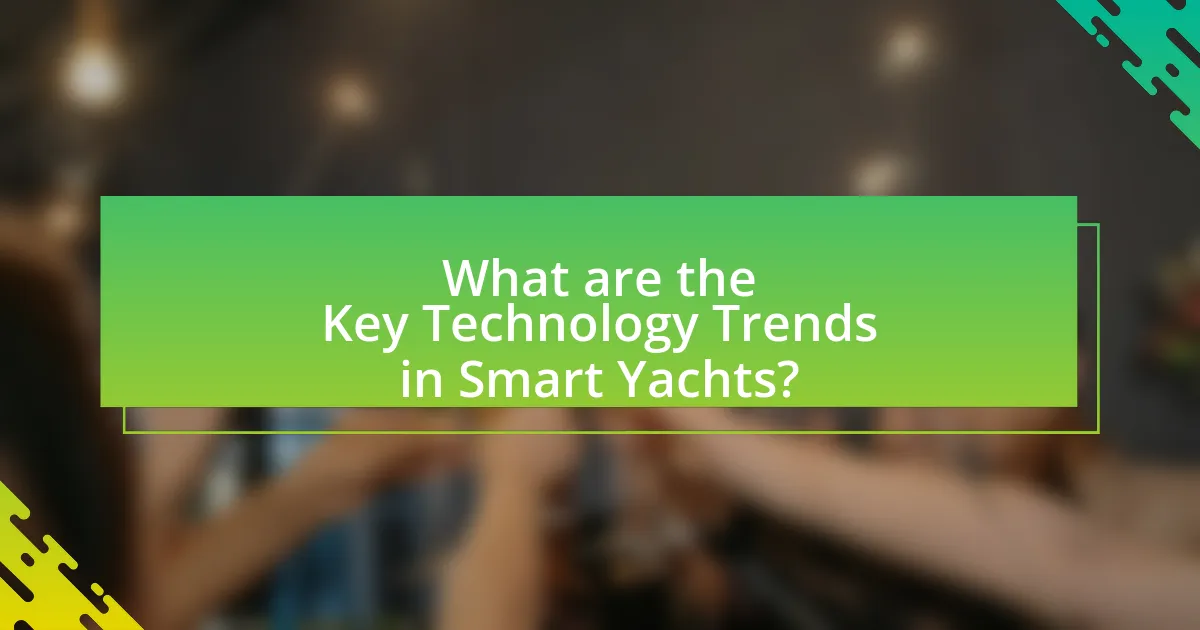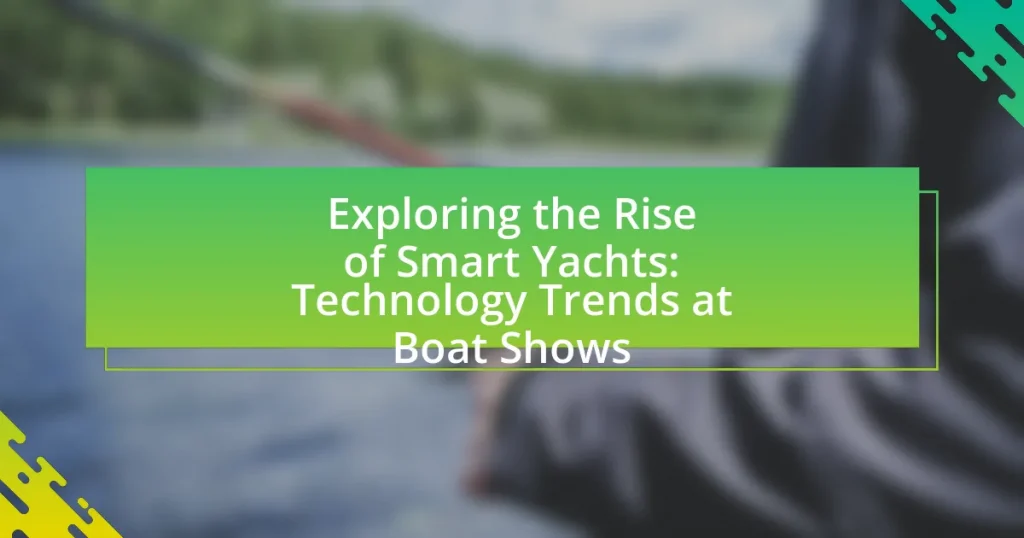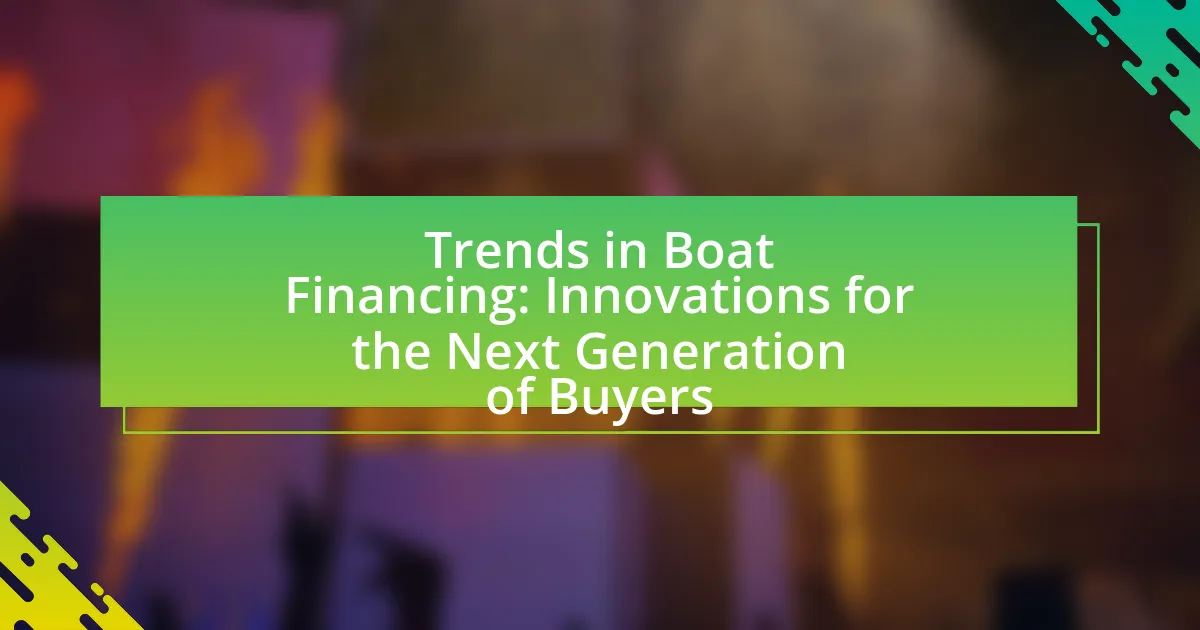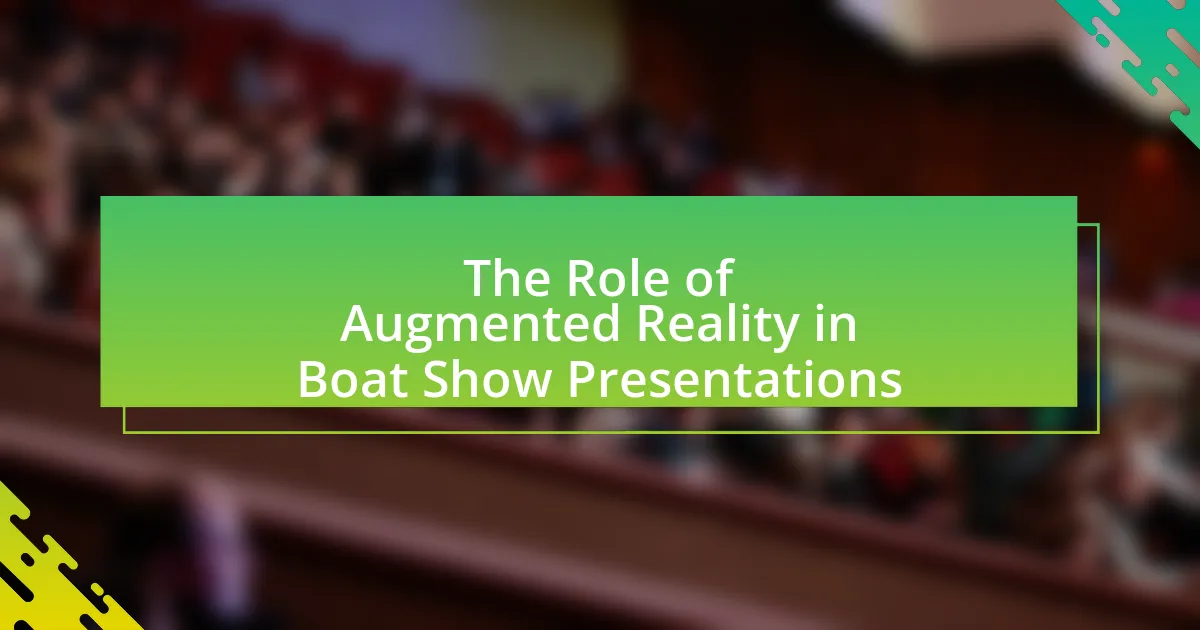Smart yachts are advanced vessels that integrate cutting-edge technology to enhance navigation, automation, and onboard comfort, leading to their rising popularity in the luxury boating market. This article explores the key technological advancements defining smart yachts, including IoT connectivity, automation systems, and energy-efficient solutions, while also examining consumer attraction to these innovations. Additionally, it highlights the significant role of boat shows in showcasing smart yacht technologies and trends, as well as the challenges and considerations associated with their adoption, such as cybersecurity risks and maintenance complexities. The future prospects for smart yachts are promising, driven by increasing consumer demand for connectivity and sustainability in yachting experiences.

What are Smart Yachts and Why are They Gaining Popularity?
Smart yachts are advanced vessels equipped with integrated technology that enhances navigation, automation, and onboard comfort. Their popularity is increasing due to the growing demand for luxury experiences, improved safety features, and the convenience of remote monitoring and control systems. According to a report by the International Council of Marine Industry Associations, the global market for smart yachts is projected to grow significantly, driven by advancements in IoT and AI technologies that allow for real-time data analysis and energy efficiency.
How do Smart Yachts differ from traditional yachts?
Smart yachts differ from traditional yachts primarily through their integration of advanced technology and automation systems. Smart yachts utilize features such as IoT connectivity, automated navigation, and remote monitoring, enhancing user experience and operational efficiency. For instance, smart yachts can be controlled via mobile apps, allowing owners to manage systems like lighting, climate, and security from anywhere. In contrast, traditional yachts typically rely on manual controls and lack these sophisticated technological integrations, which limits their operational capabilities and user convenience. The rise of smart yachts reflects a growing trend in the marine industry towards innovation and enhanced functionality, as evidenced by their increasing presence at boat shows and industry exhibitions.
What technologies define a Smart Yacht?
Smart yachts are defined by technologies such as advanced automation systems, integrated communication networks, and energy-efficient solutions. Automation systems enable remote control of onboard functions, enhancing user experience and operational efficiency. Integrated communication networks facilitate seamless connectivity for navigation, entertainment, and monitoring systems, allowing real-time data exchange. Energy-efficient solutions, including hybrid propulsion and solar power systems, contribute to sustainability and reduced operational costs. These technologies collectively enhance safety, comfort, and environmental responsibility in modern yachting.
Why are consumers attracted to Smart Yachts?
Consumers are attracted to Smart Yachts primarily due to their advanced technology and enhanced user experience. Smart Yachts integrate features such as automated navigation, energy-efficient systems, and remote monitoring, which provide convenience and safety for users. For instance, a report by the International Council of Marine Industry Associations indicates that 70% of yacht buyers prioritize technological innovation when making purchasing decisions. This trend reflects a growing demand for luxury vessels that offer both comfort and cutting-edge capabilities, making Smart Yachts increasingly appealing to consumers.
What role do boat shows play in the rise of Smart Yachts?
Boat shows significantly contribute to the rise of Smart Yachts by serving as platforms for showcasing innovative technologies and fostering industry networking. These events allow manufacturers to demonstrate advanced features such as automation, connectivity, and energy efficiency, which are hallmarks of Smart Yachts. For instance, the Cannes Yachting Festival and the Fort Lauderdale International Boat Show have featured numerous Smart Yachts equipped with cutting-edge systems like IoT integration and smart navigation tools, attracting attention from potential buyers and industry stakeholders. This exposure not only educates consumers about the benefits of Smart Yachts but also encourages manufacturers to invest in and develop smarter technologies, thereby accelerating the overall growth of the market.
How do boat shows showcase technological advancements in yachting?
Boat shows showcase technological advancements in yachting by providing a platform for manufacturers to display innovative designs and cutting-edge technologies. These events feature exhibits of smart yachts equipped with advanced navigation systems, eco-friendly propulsion methods, and integrated automation systems that enhance user experience and efficiency. For instance, the introduction of hybrid engines and solar power solutions at boat shows reflects the industry’s shift towards sustainability. Additionally, interactive demonstrations allow attendees to experience new technologies firsthand, reinforcing the importance of these advancements in modern yachting.
What trends have emerged at recent boat shows regarding Smart Yachts?
Recent boat shows have highlighted a significant trend towards the integration of advanced technology in Smart Yachts, particularly in automation and connectivity features. Exhibitors have showcased innovations such as AI-driven navigation systems, real-time data analytics for performance monitoring, and enhanced onboard connectivity through IoT devices. These advancements aim to improve user experience, safety, and energy efficiency, reflecting a growing consumer demand for smarter, more sustainable boating solutions. For instance, the 2023 Miami International Boat Show featured several models equipped with automated docking systems and remote monitoring capabilities, underscoring the industry’s shift towards high-tech solutions.

What are the Key Technology Trends in Smart Yachts?
Key technology trends in smart yachts include advanced automation systems, integrated IoT connectivity, and sustainable energy solutions. Advanced automation systems enhance navigation and onboard management, allowing for remote control and monitoring of various yacht functions. Integrated IoT connectivity enables seamless communication between devices, improving user experience and operational efficiency. Sustainable energy solutions, such as solar panels and hybrid propulsion systems, are increasingly adopted to reduce environmental impact and enhance energy efficiency. These trends reflect the industry’s shift towards smarter, more efficient, and environmentally friendly yachting experiences.
How is automation transforming the yachting experience?
Automation is transforming the yachting experience by enhancing operational efficiency and user convenience through advanced technologies. Smart yachts now integrate automated systems for navigation, engine management, and onboard amenities, allowing for seamless control via mobile devices or centralized interfaces. For instance, systems like the Volvo Penta’s Assisted Docking technology enable easier maneuvering in tight spaces, reducing the stress of docking for both novice and experienced sailors. Additionally, automation in climate control and entertainment systems personalizes the onboard experience, catering to individual preferences while optimizing energy consumption. These advancements not only improve safety and comfort but also attract a new generation of tech-savvy yacht owners, reflecting a significant shift in the industry towards smarter, more connected vessels.
What specific automated features are most popular in Smart Yachts?
The most popular automated features in Smart Yachts include advanced navigation systems, automated anchoring, and smart energy management. Advanced navigation systems utilize GPS and real-time data to optimize routes and enhance safety, while automated anchoring allows for precise positioning without manual intervention. Smart energy management systems monitor and control energy consumption, integrating renewable sources like solar power to improve efficiency. These features are increasingly adopted due to their ability to enhance safety, reduce operational costs, and improve the overall user experience on board.
How does automation enhance safety and navigation?
Automation enhances safety and navigation by integrating advanced technologies that reduce human error and improve situational awareness. Automated systems, such as collision avoidance and autopilot features, continuously monitor environmental conditions and vessel performance, allowing for timely adjustments and decision-making. For instance, the International Maritime Organization reports that human error accounts for approximately 75% of maritime accidents, highlighting the critical role automation plays in mitigating risks. Additionally, automated navigation systems utilize real-time data from GPS, radar, and sonar to provide accurate positioning and route optimization, further enhancing safety on the water.
What role does connectivity play in Smart Yachts?
Connectivity is essential in Smart Yachts as it enables seamless communication between onboard systems and external networks. This connectivity facilitates real-time data exchange, allowing for enhanced navigation, remote monitoring, and control of yacht systems, which improves safety and efficiency. For instance, advanced connectivity solutions like satellite internet and IoT devices allow yacht owners to access weather updates, engine diagnostics, and even entertainment options from anywhere. The integration of these technologies has been shown to increase operational efficiency by up to 30%, demonstrating the critical role connectivity plays in modern yachting experiences.
How do Smart Yachts utilize IoT technology?
Smart yachts utilize IoT technology to enhance onboard experiences and operational efficiency through interconnected devices and systems. These yachts integrate sensors, cameras, and smart devices that monitor and control various functions such as navigation, engine performance, and environmental conditions. For instance, IoT-enabled systems allow for real-time data collection and analysis, enabling automated adjustments to optimize fuel consumption and improve safety. Additionally, smart yachts often feature remote monitoring capabilities, allowing owners to manage their vessels from anywhere, which is supported by the growing trend of digital connectivity in marine technology.
What benefits does connectivity provide to yacht owners?
Connectivity provides yacht owners with enhanced control, safety, and access to information. With advanced connectivity, yacht owners can remotely monitor and manage onboard systems, ensuring optimal performance and security. For instance, real-time data on engine performance and fuel consumption allows for efficient operation, while GPS tracking enhances safety by enabling location sharing and emergency response. Additionally, connectivity facilitates seamless communication with crew and service providers, improving maintenance and operational efficiency. According to a report by the International Marine Industry, 70% of yacht owners prioritize connectivity features for these benefits, underscoring its importance in modern yacht ownership.

What Challenges and Considerations Exist for Smart Yachts?
Smart yachts face several challenges and considerations, including cybersecurity risks, high costs of technology integration, and regulatory compliance. Cybersecurity is critical as smart yachts are increasingly connected to the internet, making them vulnerable to hacking and data breaches. A report from the International Maritime Organization highlights that 80% of maritime cyber incidents are linked to human error, emphasizing the need for robust security measures. Additionally, the integration of advanced technologies such as IoT devices and automation systems can be prohibitively expensive, with estimates suggesting that outfitting a yacht with smart technology can increase costs by 20-30%. Regulatory compliance is another significant consideration, as yacht owners must navigate complex maritime laws and standards that vary by region, which can complicate the adoption of new technologies.
What are the potential drawbacks of Smart Yacht technology?
The potential drawbacks of Smart Yacht technology include high costs, cybersecurity risks, and reliance on technology. High costs arise from the advanced systems and components required for smart features, making them less accessible to a broader market. Cybersecurity risks are significant, as increased connectivity can expose yachts to hacking and data breaches, potentially compromising safety and privacy. Additionally, reliance on technology can lead to operational challenges, such as system failures or malfunctions, which may hinder navigation and onboard systems. These drawbacks highlight the need for careful consideration when integrating smart technology into yacht design and operation.
How do maintenance and repair differ for Smart Yachts?
Maintenance and repair for Smart Yachts differ significantly from traditional yachts due to their advanced technology integration. Smart Yachts utilize automated systems and IoT devices that require specialized knowledge for troubleshooting and repairs, whereas traditional yachts often rely on manual systems that can be serviced with general marine knowledge. For instance, Smart Yachts may have complex software systems that necessitate updates and diagnostics through specific applications, while traditional yachts typically involve mechanical repairs that can be performed without digital tools. This technological complexity in Smart Yachts leads to a need for technicians who are trained in both marine engineering and information technology, highlighting a shift in skill requirements for maintenance and repair.
What are the cybersecurity risks associated with Smart Yachts?
Smart Yachts face significant cybersecurity risks, primarily due to their reliance on interconnected systems and the Internet of Things (IoT). These risks include unauthorized access to navigation systems, which can lead to hijacking or collisions, and data breaches that expose sensitive information about the yacht and its owner. For instance, a 2020 report by the cybersecurity firm Kaspersky highlighted that 60% of connected devices on yachts are vulnerable to cyberattacks, emphasizing the need for robust security measures. Additionally, malware can disrupt onboard systems, affecting everything from engine performance to entertainment systems, thereby compromising safety and operational integrity.
How can yacht owners maximize the benefits of Smart Yachts?
Yacht owners can maximize the benefits of Smart Yachts by integrating advanced technologies such as IoT devices, automation systems, and data analytics into their vessels. These technologies enhance operational efficiency, improve safety, and provide real-time monitoring of yacht performance and environmental conditions. For instance, IoT devices can facilitate remote control of onboard systems, allowing owners to manage energy consumption and maintenance schedules effectively. Additionally, data analytics can offer insights into usage patterns, enabling owners to optimize routes and reduce fuel costs. According to a report by the International Council on Clean Transportation, smart technologies can lead to fuel savings of up to 20% in marine operations, demonstrating the tangible benefits of adopting these innovations.
What best practices should be followed for Smart Yacht maintenance?
Best practices for Smart Yacht maintenance include regular software updates, routine hardware checks, and proactive monitoring of onboard systems. Regular software updates ensure that the yacht’s operating systems and applications are secure and functioning optimally, as outdated software can lead to vulnerabilities. Routine hardware checks, including inspections of engines, electrical systems, and communication devices, help identify potential issues before they escalate into costly repairs. Proactive monitoring of onboard systems, such as navigation and safety equipment, allows for real-time diagnostics and alerts, enhancing safety and performance. These practices are essential for maintaining the efficiency and longevity of Smart Yachts, which rely heavily on integrated technology for operation.
How can owners stay updated on the latest technology trends?
Owners can stay updated on the latest technology trends by regularly attending industry events, subscribing to relevant publications, and engaging with online communities. Industry events, such as boat shows, showcase the latest innovations and provide networking opportunities with experts and other owners. Subscribing to publications like “Yachting Magazine” or “Boat International” offers insights into emerging technologies and trends. Additionally, participating in online forums and social media groups focused on yachting technology allows owners to share knowledge and stay informed about advancements in smart yacht technologies.
What are the future prospects for Smart Yachts?
The future prospects for Smart Yachts are promising, driven by advancements in technology and increasing consumer demand for connectivity and automation. The integration of IoT devices, AI, and advanced navigation systems is expected to enhance user experience, safety, and energy efficiency. According to a report by Grand View Research, the global smart yacht market is projected to grow significantly, with a compound annual growth rate (CAGR) of over 10% from 2021 to 2028. This growth is fueled by the rising popularity of luxury experiences and the demand for sustainable boating solutions.
How might emerging technologies further influence Smart Yachts?
Emerging technologies will significantly enhance Smart Yachts by integrating advanced automation, artificial intelligence, and IoT connectivity. These technologies enable real-time monitoring and control of yacht systems, improving energy efficiency and safety. For instance, AI algorithms can optimize navigation routes based on weather patterns and sea conditions, while IoT devices allow for remote diagnostics and maintenance alerts, reducing downtime. According to a report by the International Marine Organization, the adoption of smart technologies in marine vessels can lead to a 20% reduction in fuel consumption, demonstrating the tangible benefits of these innovations in Smart Yachts.
What trends should potential buyers watch for in the coming years?
Potential buyers should watch for the increasing integration of advanced technology in smart yachts, particularly in automation, connectivity, and sustainability. Automation features, such as autonomous navigation and smart home systems, are becoming standard, enhancing user experience and safety. Connectivity advancements, including IoT integration and mobile app controls, allow for seamless management of yacht systems remotely. Additionally, sustainability trends are driving the adoption of eco-friendly materials and energy-efficient technologies, with a growing emphasis on hybrid and electric propulsion systems. According to the 2023 Global Yacht Market Report, the demand for smart yachts is projected to grow by 15% annually, reflecting these technological advancements and consumer preferences.





